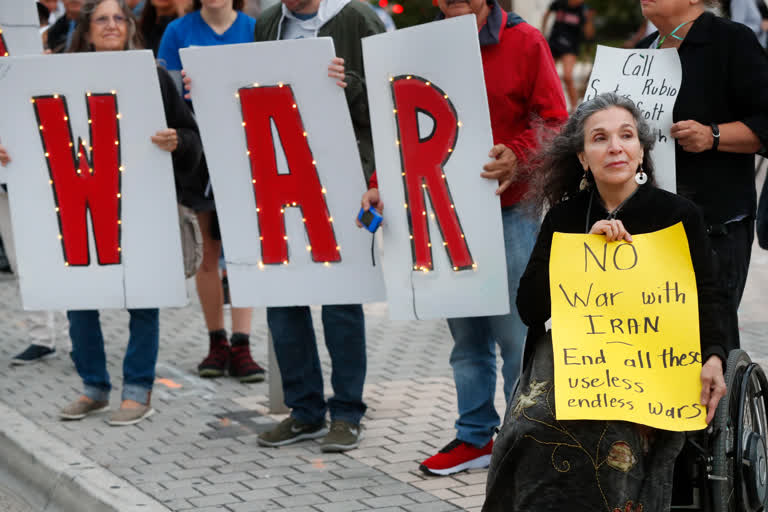New Delhi: The assassination of the Commander of the Quds Force of Iran’s Revolutionary Guards Major General Qasem Soleimani on 3 January 2020 through an airstrike authorised by President Donald Trump of the United States, and the retaliatory missile attacks by Iran against U.S. bases in Iraq on 8 January 2020, have brought into sharp focus India’s challenges in the region.
India’s official response has stressed the need for “peace, stability and security in this region” while advocating restraint. In the case of the Gulf region India has vital interests at stake. Indian diplomacy must be proactive to calibrate India’s political and economic interests to protect these interests from being adversely impacted by instability in the region.
Political instability in the region has major implications for India’s largest asset in the region, viz. the 8 million Indian passport holders who currently work in the Gulf economies, remitting about $40 billion dollars annually into India’s economy. The immediate challenge for India’s diplomacy is to prevent a sudden exodus of Indian workers. This is easier said than done, given the huge numbers involved, and the fact that most Indian citizens working in the Gulf have not been sent there by the government of India. Examples of India’s evacuation of her citizens from Yemen in April 2015 (numbering about 5000) and Libya in 2011 (numbering 18,000) pale in the face of the challenge of looking to evacuate millions of Indian nationals in the region. India’s objective must be to engage actively with regional and major powers to ensure political stability in the Gulf to ensure that her citizens continue to be productively employed in the regional economy.
The second major challenge for India lies in the fact that the Gulf region accounts for almost 60% of India’s total imports of crude oil and natural gas, which were worth about $112 billion in 2018. India is today the world’s third largest importer of crude oil. Despite drastically reducing her imports of Iranian oil due to the impact of unilateral U.S. economic sanctions on payment for such imports, the current instability in the region has added significant costs for India’s import bill of crude oil. This also affects petroleum-linked sectors in India’s domestic economy. Ensuring the predictability of required quantities of energy supplies at realistic prices is a challenge for India’s energy diplomacy.
A third specific area of interest for India is to keep open for navigation the two major sea lanes of communication in the Gulf region. These lanes traverse the Straits of Hormuz and the Persian Gulf between Iran and the Arabian Peninsula, and the Bab al-Mandab Straits between Yemen and the Horn of Africa connecting the Red Sea to the Indian Ocean. In March 2015, Prime Minister Narendra Modi had articulated a Security and Growth for All in the Region (SAGAR) Indian Ocean policy, in which the security of sea lanes is a priority. Subsequently, in November 2019, an Information Fusion Centre for the Indian Ocean Region (IFC-IOR) was established in Gurugram in India for Maritime Domain Awareness to “detect and deter maritime security threats of the region”.
Also Read: US-Iran at war: Military strengths of two nations
India deployed 2 naval ships in June 2019 to protect India’s commercial shipping in the Persian Gulf. With instability in the Gulf escalating rapidly, securing the sea lanes would need to involve “mutual collaboration and exchange of information and understanding” between all stakeholders in the region. In view of the inability of the UN Security Council to act to contain the current crisis, India must look at a regional initiative, bringing together countries, especially in the Gulf region, who have mutual security, economic and energy interests on ensuring the political stability of the region.
The larger objective for a proactive diplomatic strategy by India is to ensure that the instability in the region does not adversely impact on her international trade. In the Gulf, the UAE is India’s largest trading partner, with two-way trade worth almost $60 billion in 2018. The sea lane through the Bab al-Mandab transports the bulk of India’s trade with the West, including the European Union, which is India’s largest trading partner. India-EU goods trade was worth $102 billion in 2018. Two major fibre-optic cables connect Digital India with Europe and the outside world through the Bab al-Mandab, providing the infrastructure for India’s growing role in global electronic commerce.
Also Read: Will welcome any Indian peace initiative for de-escalating tensions with US: Iran
International trade already contributes 40% of India’s GDP, and is critical for India’s declared objective of becoming a $5 trillion economy by 2025. Taking specific steps to de-escalate the tensions in the Gulf region through bilateral and regional diplomacy would help India meet this objective.
By Asoke Mukerji, former ambassador of India to the United Nations



